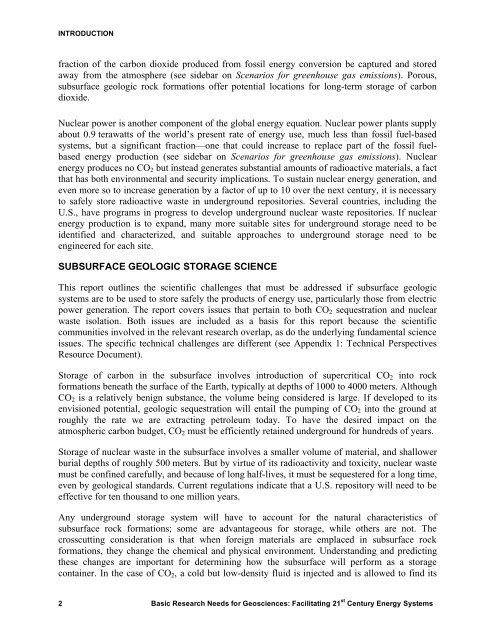Basic Research Needs for Geosciences - Energetics Meetings and ...
Basic Research Needs for Geosciences - Energetics Meetings and ...
Basic Research Needs for Geosciences - Energetics Meetings and ...
- No tags were found...
Create successful ePaper yourself
Turn your PDF publications into a flip-book with our unique Google optimized e-Paper software.
INTRODUCTIONfraction of the carbon dioxide produced from fossil energy conversion be captured <strong>and</strong> storedaway from the atmosphere (see sidebar on Scenarios <strong>for</strong> greenhouse gas emissions). Porous,subsurface geologic rock <strong>for</strong>mations offer potential locations <strong>for</strong> long-term storage of carbondioxide.Nuclear power is another component of the global energy equation. Nuclear power plants supplyabout 0.9 terawatts of the world’s present rate of energy use, much less than fossil fuel-basedsystems, but a significant fraction—one that could increase to replace part of the fossil fuelbasedenergy production (see sidebar on Scenarios <strong>for</strong> greenhouse gas emissions). Nuclearenergy produces no CO 2 but instead generates substantial amounts of radioactive materials, a factthat has both environmental <strong>and</strong> security implications. To sustain nuclear energy generation, <strong>and</strong>even more so to increase generation by a factor of up to 10 over the next century, it is necessaryto safely store radioactive waste in underground repositories. Several countries, including theU.S., have programs in progress to develop underground nuclear waste repositories. If nuclearenergy production is to exp<strong>and</strong>, many more suitable sites <strong>for</strong> underground storage need to beidentified <strong>and</strong> characterized, <strong>and</strong> suitable approaches to underground storage need to beengineered <strong>for</strong> each site.SUBSURFACE GEOLOGIC STORAGE SCIENCEThis report outlines the scientific challenges that must be addressed if subsurface geologicsystems are to be used to store safely the products of energy use, particularly those from electricpower generation. The report covers issues that pertain to both CO 2 sequestration <strong>and</strong> nuclearwaste isolation. Both issues are included as a basis <strong>for</strong> this report because the scientificcommunities involved in the relevant research overlap, as do the underlying fundamental scienceissues. The specific technical challenges are different (see Appendix 1: Technical PerspectivesResource Document).Storage of carbon in the subsurface involves introduction of supercritical CO 2 into rock<strong>for</strong>mations beneath the surface of the Earth, typically at depths of 1000 to 4000 meters. AlthoughCO 2 is a relatively benign substance, the volume being considered is large. If developed to itsenvisioned potential, geologic sequestration will entail the pumping of CO 2 into the ground atroughly the rate we are extracting petroleum today. To have the desired impact on theatmospheric carbon budget, CO 2 must be efficiently retained underground <strong>for</strong> hundreds of years.Storage of nuclear waste in the subsurface involves a smaller volume of material, <strong>and</strong> shallowerburial depths of roughly 500 meters. But by virtue of its radioactivity <strong>and</strong> toxicity, nuclear wastemust be confined carefully, <strong>and</strong> because of long half-lives, it must be sequestered <strong>for</strong> a long time,even by geological st<strong>and</strong>ards. Current regulations indicate that a U.S. repository will need to beeffective <strong>for</strong> ten thous<strong>and</strong> to one million years.Any underground storage system will have to account <strong>for</strong> the natural characteristics ofsubsurface rock <strong>for</strong>mations; some are advantageous <strong>for</strong> storage, while others are not. Thecrosscutting consideration is that when <strong>for</strong>eign materials are emplaced in subsurface rock<strong>for</strong>mations, they change the chemical <strong>and</strong> physical environment. Underst<strong>and</strong>ing <strong>and</strong> predictingthese changes are important <strong>for</strong> determining how the subsurface will per<strong>for</strong>m as a storagecontainer. In the case of CO 2 , a cold but low-density fluid is injected <strong>and</strong> is allowed to find its2 <strong>Basic</strong> <strong>Research</strong> <strong>Needs</strong> <strong>for</strong> <strong>Geosciences</strong>: Facilitating 21 st Century Energy Systems
















